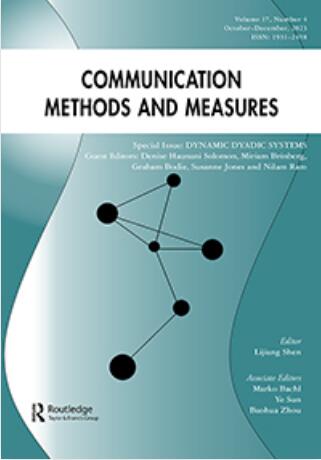Enhancing Theory-Informed Dictionary Approaches with “Glass-box” Machine Learning: The Case of Integrative Complexity in Social Media Comments
IF 3.7
1区 文学
Q1 COMMUNICATION
引用次数: 6
Abstract
ABSTRACT Dictionary-based approaches to computational text analysis have been shown to perform relatively poorly, particularly when the dictionaries rely on simple bags of words, are not specified for the domain under study, and add word scores without weighting. While machine learning approaches usually perform better, they offer little insight into (a) which of the assumptions underlying dictionary approaches (bag-of-words, domain transferability, or additivity) impedes performance most, and (b) which language features drive the algorithmic classification most strongly. To fill both gaps, we offer a systematic assumption-based error analysis, using the integrative complexity of social media comments as our case in point. We show that attacking the additivity assumption offers the strongest potential for improving dictionary performance. We also propose to combine off-the-shelf dictionaries with supervised “glass box” machine learning algorithms (as opposed to the usual “black box” machine learning approaches) to classify texts and learn about the most important features for classification. This dictionary-plus-supervised-learning approach performs similarly well as classic full-text machine learning or deep learning approaches, but yields interpretable results in addition, which can inform theory development on top of enabling a valid classification.用“玻璃盒”机器学习增强理论知情词典方法:社交媒体评论中整合复杂性的案例
摘要基于词典的计算文本分析方法表现相对较差,尤其是当词典依赖于简单的单词袋,没有为研究领域指定,并且在没有加权的情况下添加单词得分时。虽然机器学习方法通常表现更好,但它们几乎没有深入了解(a)字典方法背后的哪些假设(单词袋、域可转移性或可加性)对性能的影响最大,以及(b)哪些语言特征对算法分类的驱动力最强。为了填补这两个空白,我们提供了一个系统的基于假设的错误分析,以社交媒体评论的综合复杂性为例。我们表明,攻击可加性假设为提高字典性能提供了最大的潜力。我们还建议将现成的词典与有监督的“玻璃盒”机器学习算法(与通常的“黑匣子”机器学习方法相反)相结合,对文本进行分类,并了解最重要的分类特征。这种字典加监督学习方法的性能与经典的全文机器学习或深度学习方法类似,但还产生了可解释的结果,这可以为理论发展提供信息,同时实现有效的分类。
本文章由计算机程序翻译,如有差异,请以英文原文为准。
求助全文
约1分钟内获得全文
求助全文
来源期刊

Communication Methods and Measures
COMMUNICATION-
CiteScore
21.10
自引率
1.80%
发文量
9
期刊介绍:
Communication Methods and Measures aims to achieve several goals in the field of communication research. Firstly, it aims to bring attention to and showcase developments in both qualitative and quantitative research methodologies to communication scholars. This journal serves as a platform for researchers across the field to discuss and disseminate methodological tools and approaches.
Additionally, Communication Methods and Measures seeks to improve research design and analysis practices by offering suggestions for improvement. It aims to introduce new methods of measurement that are valuable to communication scientists or enhance existing methods. The journal encourages submissions that focus on methods for enhancing research design and theory testing, employing both quantitative and qualitative approaches.
Furthermore, the journal is open to articles devoted to exploring the epistemological aspects relevant to communication research methodologies. It welcomes well-written manuscripts that demonstrate the use of methods and articles that highlight the advantages of lesser-known or newer methods over those traditionally used in communication.
In summary, Communication Methods and Measures strives to advance the field of communication research by showcasing and discussing innovative methodologies, improving research practices, and introducing new measurement methods.
 求助内容:
求助内容: 应助结果提醒方式:
应助结果提醒方式:


